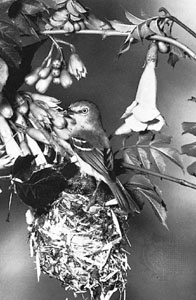vireo
bird
 any of about 50 species of New World birds (bird) in the order Passeriformes (passeriform). These include peppershrikes (peppershrike) and, according to some authorities, the shrike-vireos (shrike-vireo). About 15 tropical forms are called greenlets (greenlet), which used to be the common name for all vireos.
any of about 50 species of New World birds (bird) in the order Passeriformes (passeriform). These include peppershrikes (peppershrike) and, according to some authorities, the shrike-vireos (shrike-vireo). About 15 tropical forms are called greenlets (greenlet), which used to be the common name for all vireos.New evidence from DNA places vireos as relatives of crows (crow), which are among the most evolutionarily advanced birds. Vireos are found only in the New World and are mostly rather plain and shy. They are usually 10 to 18 cm (4 to 7 inches) long, and both sexes are gray or green with white or yellow touches. The slightly notched and hook-tipped bill is stout but narrow, with fine bristles at the base. Vireos forage in trees and bushes for insects (insect) and take berries (berry) in fall and winter. Often they repeat loud short phrases over and over. Many vireos have distinctive courtship displays, in which they sometimes sway and flutter, and they often examine potential nest sites together. The vireo's nest is a cuplike structure suspended from a small fork of a branch, and the bird's eggs (egg) are white with sparse reddish-brown speckles.
The best-known and most widely distributed species of vireo is the red-eyed vireo (Vireo olivaceus), which breeds from southern Canada to Argentina. It is 15 cm (6 inches) long, with a black-outlined white eye stripe that contrasts with the bird's gray crown. Similar in general appearance is the white-eyed vireo (V. griseus). In Bermuda, where it is common, it is known as “chick-of-the-village,” a moniker that repeats its snappy, distinctive song. The cheerful warbled song of the warbling vireo (V. gilvus) is a common sound in open woods throughout the North American summer. Like many vireos, warbling vireos migrate south in the autumn, flying at night and calling to their fellows as they fly.